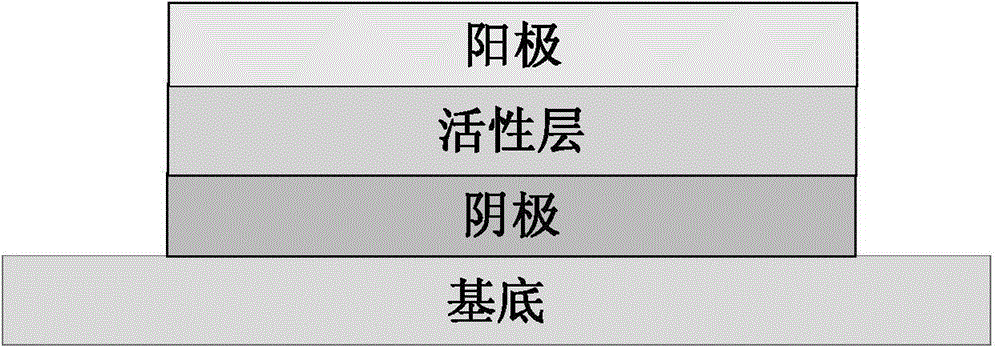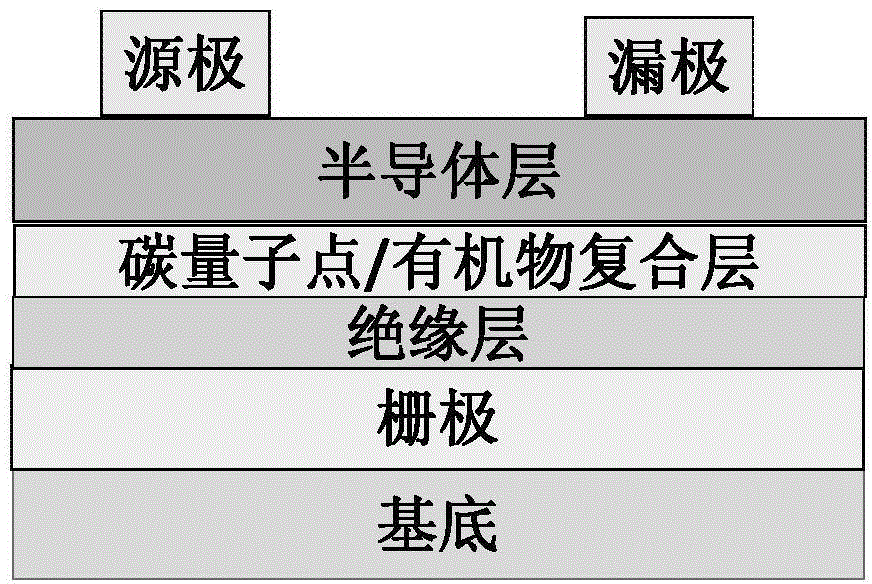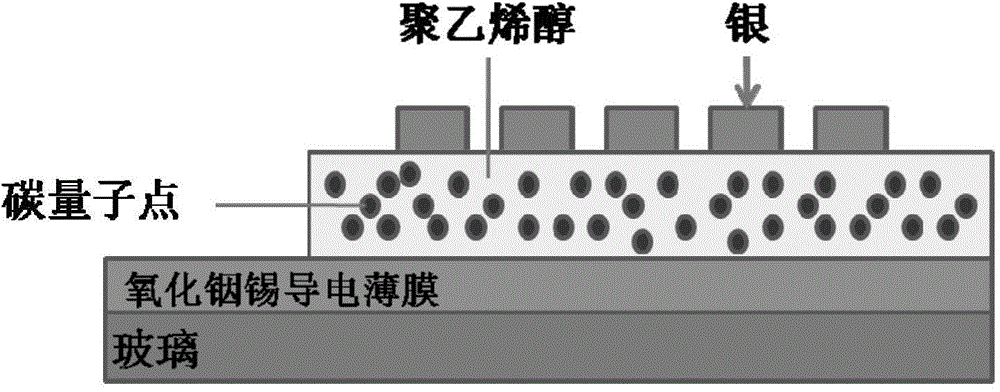Memory storage device based on carbon dot/organic polymer composite material
A composite material, memory storage technology, applied in the field of new organic storage materials, can solve problems such as no reports, and achieve excellent performance, long retention time, and good stability.
- Summary
- Abstract
- Description
- Claims
- Application Information
AI Technical Summary
Problems solved by technology
Method used
Image
Examples
Embodiment 1
[0049] A method for preparing a two-terminal diode memory storage device, comprising the following steps:
[0050] 1) Dissolving a blend of polyvinyl alcohol PVA and carbon dots doped with N heteroatoms in an aqueous solution at a weight ratio of 50:1 to obtain a mixed solution, which is a composite material;
[0051] 2) Deposit cathode electrode material gold on the surface of indium tin oxide transparent conductive glass, spin-coat the composite material obtained in 1) onto the surface of the gold electrode to form an active layer, and the thickness of the active layer is about 70nm;
[0052] After that, anneal at 100°C for 30min;
[0053] Finally, a metal silver electrode (thickness 100nm) is deposited on the surface of the active layer under vacuum by a coating machine to obtain a nonvolatile two-terminal diode memory device based on heteroatom-doped carbon dots.
[0054] Measured switch ratio up to 10 5 .
[0055] The structural formula of polyvinyl alcohol PVA is as f...
Embodiment 2
[0061] A preparation method for a three-terminal memory storage device, comprising the following steps:
[0062] (1) Deposit gate (gold) and insulating layer (silicon dioxide) sequentially on the base material ITO substrate according to conventional methods;
[0063] (2) Dissolving polyvinyl alcohol PVA and carbon dots doped with S heteroatoms in methanol at a weight ratio of 2:1 to obtain a mixed solution, which is a composite material;
[0064] (3) The composite material is deposited on the surface of the insulating layer by spin coating, printing, etc. to form a charge trapping layer;
[0065] Using a semiconductor film forming method, depositing pentacene material on the surface of the charge trapping layer to form a semiconductor layer with a thickness of 10nm;
[0066] Depositing at least one layer of patterned silver, copper, gold and other metals on the surface of the semiconductor layer to form source and drain electrodes;
[0067] Obtained a non-volatile three-term...
Embodiment 3
[0071] A method for preparing a two-terminal diode memory storage device, comprising the following steps:
[0072] 1) Organic polymer (poly-p-phenylene vinylene, a mixture of poly-p-phenylene vinylene derivatives, polyacetylene and polyacetylene derivatives in a weight ratio of 1:2:2:1) and carbon The point blend was stirred in an aqueous solution at a weight ratio of 50:1 at 30°C for 10 minutes to obtain a mixed solution, which was a composite material; the concentration of the organic polymer was 10 mg / ml;
[0073] 2) Deposit the silver cathode electrode material on the surface of the silicon base material, pull the composite material obtained in step 1) to the surface of the silver cathode electrode material to form an active layer (thickness is 20nm), then anneal at 60°C for 10min, and finally use a coating machine on the surface of the silver cathode electrode material. The anode electrode material ITO (thickness: 20nm) was evaporated on the surface of the active layer un...
PUM
| Property | Measurement | Unit |
|---|---|---|
| concentration | aaaaa | aaaaa |
| thickness | aaaaa | aaaaa |
| thickness | aaaaa | aaaaa |
Abstract
Description
Claims
Application Information
 Login to View More
Login to View More - R&D
- Intellectual Property
- Life Sciences
- Materials
- Tech Scout
- Unparalleled Data Quality
- Higher Quality Content
- 60% Fewer Hallucinations
Browse by: Latest US Patents, China's latest patents, Technical Efficacy Thesaurus, Application Domain, Technology Topic, Popular Technical Reports.
© 2025 PatSnap. All rights reserved.Legal|Privacy policy|Modern Slavery Act Transparency Statement|Sitemap|About US| Contact US: help@patsnap.com



